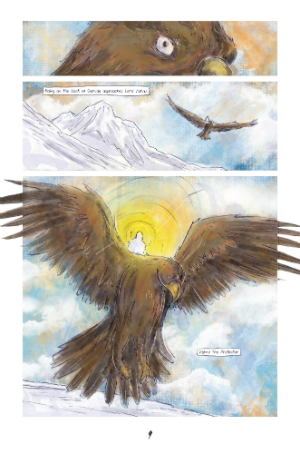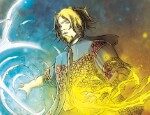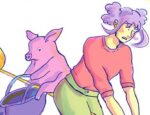In their self-published book Flirting with Death, writer Rudra Purkayastha and artists Lyndon White and Paulina Vassileva bring readers six thought-provoking and gorgeously-illustrated stories that teach us about Life.
Just as our shadow keeps pace with our every step, Death inexorably follows close on the heels of Life. The sagely Beatle George Harrison once intoned “All Things Must Pass.” And, it is often through contemplating, acknowledging, and accepting this fact that we gain a deeper understanding of what it means to be alive.
 Rudra Purkayastha, whose creative pursuits extend from comics to film-making and writing magazine articles, has found a voice as a storyteller with his six contributions in Flirting with Death. Utilizing characters, stories, and concepts culled from religious mythology, existential philosophy, and astrophysics, Purkayastha gives readers a wide range of meditations on the themes of Life and Death that result in more profound insight into each.
Rudra Purkayastha, whose creative pursuits extend from comics to film-making and writing magazine articles, has found a voice as a storyteller with his six contributions in Flirting with Death. Utilizing characters, stories, and concepts culled from religious mythology, existential philosophy, and astrophysics, Purkayastha gives readers a wide range of meditations on the themes of Life and Death that result in more profound insight into each.
‘The Little Bird’, featuring deities from Hindu mythology, leads things off and sets the tone for the entire anthology. The god Vishnu – The Protector – is carried aloft through a vast mountain range on the back of his eagle, Garuda, to a door that sits strangely atop a peak. He has come to meet the god Shiva – The Destroyer – to speak on “matters of creation, matters of life and of death” beyond the scope of mere mortals.
Vishnu enters the door while Garuda waits and ponders the expansive surroundings. The eagle spies a little bird in the snow and is charmed by its beauty and fragility. Upon arrival, Shiva glances at the bird as he makes his way through the door. Aware of the god’s destructive power to kill with but a thought, Garuda fears for the little bird and whisks it away down the mountain to a lowland forest where he thinks it will be safe. However, a snake (the proxy of Shiva) finds the bird and devours it. This succinct allegory illuminates the fact that nothing, no matter how well-protected, is beyond the reach of death’s hand.
Purkayastha continues to employ this deceptively simple yet effective approach – one akin to the classic morality parables of Aesop’s Fables – throughout the remaining vignettes in Flirting with Death. In ‘Simon Lundy’, the seven days of the week serve as plot points for an excellent story about the cycle of birth, life, death, decay, and resurrection. In ‘Therefore I Am’, a man engages an artificially-intelligent robot in a philosophical discussion and refutes Descartes’ famous assertion on the grounds that Love, not Thought, is the basis for human existence. And, in ‘Cosmic Fish’, the essence of being, embodied by a goldfish, is measured against the infinite (and infinitesimal) scale of the Universe.
‘The Little Bird’ and ‘Simon Lundy’
The bulk of the illustration in Flirting with Death is handled by Lyndon White with one exception: artist Paulina Vassileva skillfully brings her bold and fluid line work to ‘Red on the Plains of Sinai’, a re-imagining of the biblical story of the Golden Calf as told from the perspective of the followers of Moses who are condemned to merciless slaughter by “the one true God” for their well-intentioned idolatry. It’s a brilliant stab at the hypocrisy embedded in the Judeo-Christian value of “forgiveness.”
By turns realistic and impressionistic, White’s colorful sketch-work wholly serves as an elegant visual companion to Purkayastha’s storytelling. He uses strong hues applied in an almost-watercolor artistic style which adeptly engages the eye with the material. Moreover, his competent panel arrangements wrangle the heady philosophical themes of the book into easily-digestible storyboards.
‘Cosmic Fish’ and ‘Red on the Plains of Sinai’
The fine dove-tailing of words and art is most evident in the final story, from which the overall collection takes its name. ‘Flirting with Death’ is a tale that moves in and out of reality as a young woman explains to Shiva – who returns in the same guise as he was depicted in the first story, making for a fitting bookend effect – why she has decided to end her own life. (Notable is the “flirtatious” tone of their conversation, an obvious nod to the book’s title.)
In an attempt to rescue victims from a house fire, she leaves her little brother unattended and he ends up dying in the inferno. However, it isn’t the insurmountable guilt or grief over her brother’s death that has brought her to contemplate suicide; rather, it’s the all-too-common numbness – the ennui – towards Life and its apparent meaninglessness that has led her to this crossroads. Shiva, earnestly attempting to reason with her, finally relents: in the end, it’s s a personal choice to embrace Life or to turn one’s back on it. Either way, everyone’s destiny is the same – all things must pass.
‘Therefore I Am’ and ‘Flirting with Death’
None of the six tales in Flirting with Death extend beyond a dozen pages or so (most are half that length), and this literary/artistic efficiency is the true strength of the book. Instead of getting bogging down in a quagmire of lengthy diatribes on deep philosophical questions, the writer and the artists cleverly streamline things to give the stories a poetic tone with a healthy pace, thus keeping the reader captivated with each new story’s thematic journey.
An undertaking such as this could easily have swung on a pendulum between too much whimsy or too much gravity; but this book, for all of its blurring of the lines between reality and fantasy, still feels incredibly grounded. Purkayastha, White, and Vassileva have deftly trod a delicate path through these six explorations of the Human Condition, creating an exceptional book that should be read by everyone.
Rudra Purkayastha (W) Lyndon White and Paulina Vassileva (A) • Untold Voyages, £9.99 (print), £4.99 (digital)




















